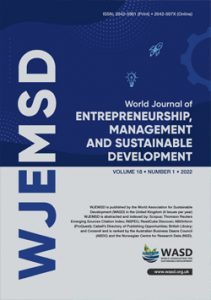Entrepreneurial orientation and performance: the interaction effect of customer capital, Alireza Jalali, Mastura Jaafar and Prof. Thurasamy Ramayah
 Alireza Jalali
Alireza Jalali
Quantitative Survey Department
University Sains Malaysia, Penang
Malaysia
Email: arjiaa@yahoo.com
Mastura Jaafar
Project Management Department
University Sains Malaysia, Penang
Malaysia
Prof. Thurasamy Ramayah
School of Management
University Sains Malaysia, Penang
Malaysia
DOI: 10.1108/WJEMSD-05-2013-0030
Purpose: The purpose of this study is to advance research on entrepreneurial orientation (EO), resource-based view (RBV), customer (relational) capital, and small and medium enterprises (SMEs) by examining how the interaction effect of customer capital shapes the relationship between EO and firm performance.
Design/methodology/approach: This research is considered as a correlational rather than a casual study with 150 questionnaire returned from manufacturing SMEs. This cross-sectional study tested all hypotheses that are related to the research questions and use statistical software SPSS 17 to analyze data.
Findings: The study found that a high customer capital strengthens the link between two dimensions of EO (innovativeness and risk taking) and weakens the link between another dimension of EO (proactiveness) and firm performance.
Research limitations/implications: First, future studies would benefit from an enhanced development in the measurement of EO dimensions, which relies on richer and more refined conceptualizations. Second, a single informant who was asked to evaluate EO may potentially increase the degree of subjectivity and bias in the responses. Obtaining more than one respondent for the survey from each organization is always highly desirable.
Practical implications: The results of the current study cover the limitation of the previous study by independently examining the moderating effect of customer capital as an intangible resource in the relationship between innovativeness and risk taking on firm performance. The paper expands this line of work by adding the idea that the intangible resources of a firm are more likely to contribute to sustaining superior firm performance when they are used with other factors simultaneously.
Social implications: Environmental factors, such as government financial aid and protection of organizations outside the industry, may affect the relationship between SMEs and the agents. Establishing extra ties between Iranian firms and agents may be expensive for Iranian manufacturing firms, and they may not be able to create these ties without government support.
Originality/value: A research gap exists in understanding how customer capital operates and endows benefits to firms that are beyond their start-up phase and are embarking on international activities. The current study tries to overcome a number of limitations of the previous framework by combining RBV and customer capital. Particularly, “the RBV's lack of specificity have raised questions as to its status as a legitimate theory, and make it difficult to design and test empirically.”
Keywords: Performance; Entrepreneurship; Customer capital; Entrepreneurial orientation; Performance; Small and medium enterprises; Resource-based view; Iran.
Citation: Jalali, A., Jaafar, M. and Ramayah, T. (2014), "Entrepreneurial orientation and performance: the interaction effect of customer capital", World Journal of Entrepreneurship, Management and Sustainable Development, Vol. 10 No. 1, pp. 48-68. https://doi.org/10.1108/WJEMSD-05-2013-0030

